Twitter's Strategic Management: Business Development and Analysis
VerifiedAdded on 2023/01/09
|21
|4852
|66
Report
AI Summary
This report provides a comprehensive analysis of Twitter's strategic management and business development. It begins by differentiating between deliberate and emergent strategies, arguing that Twitter employs a deliberate strategy focused on profitability and minimizing external influences. The report explains Twitter's dynamic capabilities, particularly in adapting to rapid technological change and evolving customer needs, which contribute to its competitive advantage. It then examines Twitter's external environment through PESTLE and Porter's Five Forces analyses, highlighting political, economic, social, technological, legal, and environmental factors affecting the company. Internal analysis includes SWOT and VRIO frameworks to assess Twitter's strengths, weaknesses, opportunities, and threats, as well as the value of its resources. The report also considers Porter's Generic Strategies, identifying Twitter's chosen strategy and using a TOWS matrix to explore strategic options. Finally, the SAF model is applied to evaluate future strategies for Twitter, ensuring suitability, acceptability, and feasibility. The analysis is supported by various models and frameworks to provide a detailed overview of Twitter's strategic landscape.
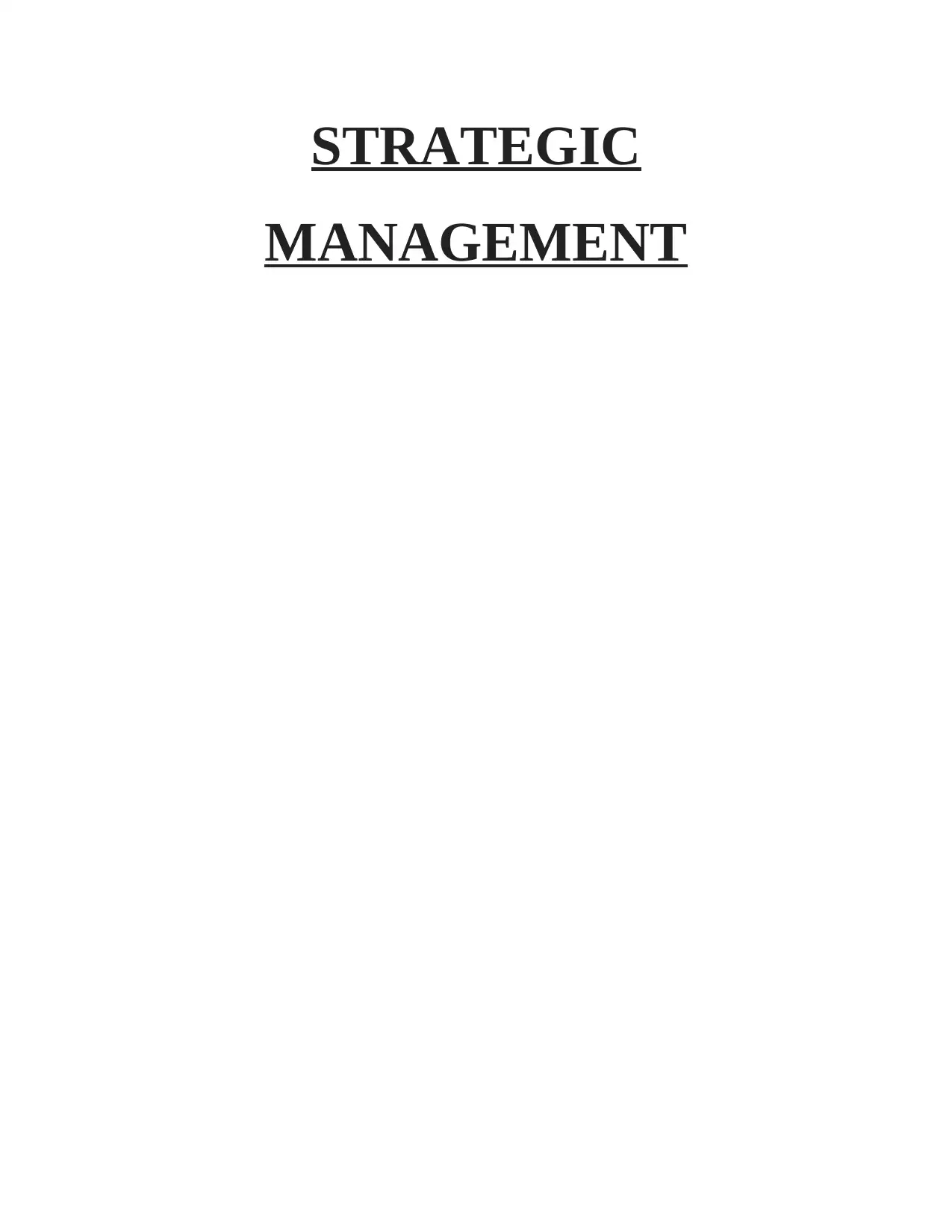
STRATEGIC
MANAGEMENT
MANAGEMENT
Paraphrase This Document
Need a fresh take? Get an instant paraphrase of this document with our AI Paraphraser
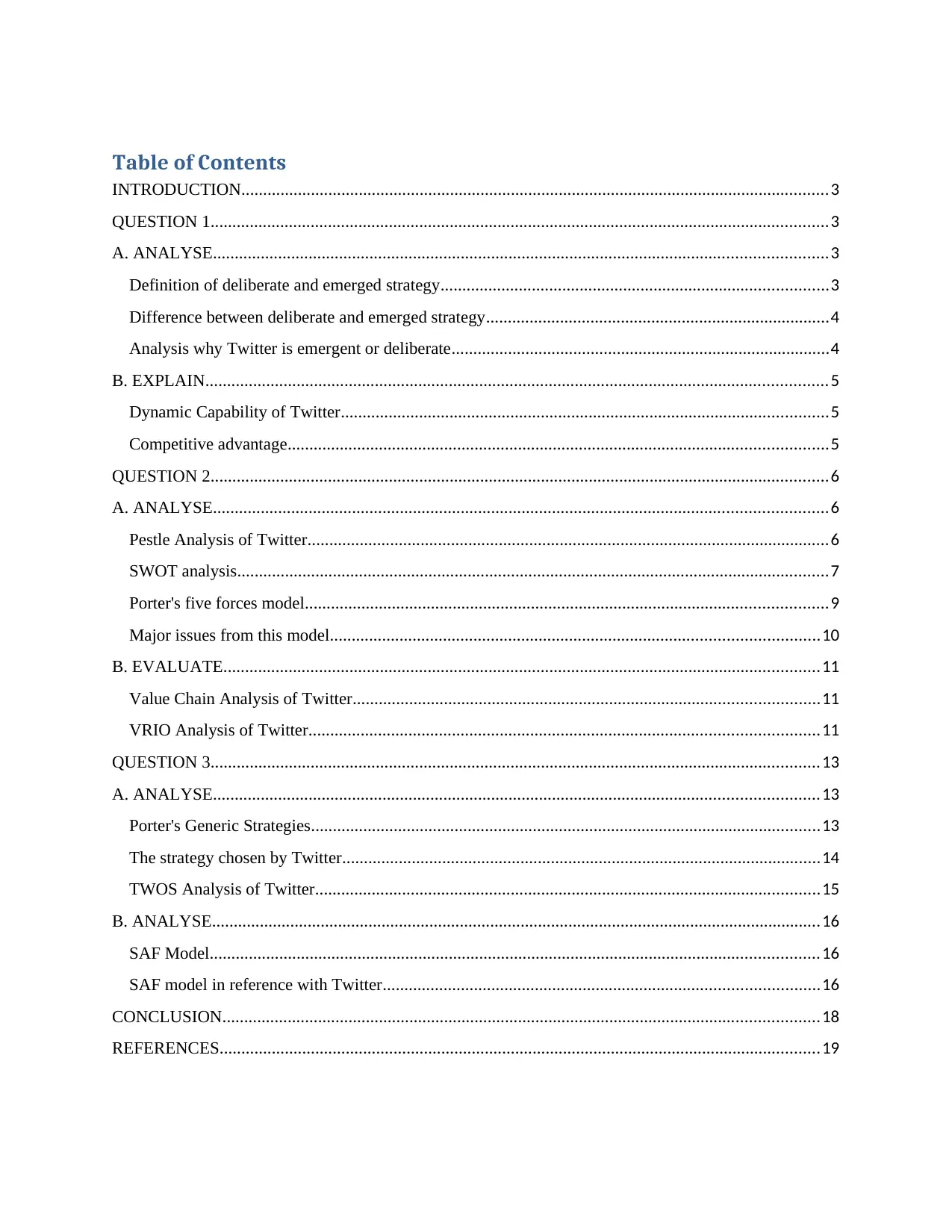
Table of Contents
INTRODUCTION.......................................................................................................................................3
QUESTION 1..............................................................................................................................................3
A. ANALYSE.............................................................................................................................................3
Definition of deliberate and emerged strategy.........................................................................................3
Difference between deliberate and emerged strategy...............................................................................4
Analysis why Twitter is emergent or deliberate.......................................................................................4
B. EXPLAIN...............................................................................................................................................5
Dynamic Capability of Twitter................................................................................................................5
Competitive advantage............................................................................................................................5
QUESTION 2..............................................................................................................................................6
A. ANALYSE.............................................................................................................................................6
Pestle Analysis of Twitter........................................................................................................................6
SWOT analysis........................................................................................................................................7
Porter's five forces model........................................................................................................................9
Major issues from this model................................................................................................................10
B. EVALUATE.........................................................................................................................................11
Value Chain Analysis of Twitter...........................................................................................................11
VRIO Analysis of Twitter.....................................................................................................................11
QUESTION 3............................................................................................................................................13
A. ANALYSE...........................................................................................................................................13
Porter's Generic Strategies.....................................................................................................................13
The strategy chosen by Twitter..............................................................................................................14
TWOS Analysis of Twitter....................................................................................................................15
B. ANALYSE............................................................................................................................................16
SAF Model............................................................................................................................................16
SAF model in reference with Twitter....................................................................................................16
CONCLUSION.........................................................................................................................................18
REFERENCES..........................................................................................................................................19
INTRODUCTION.......................................................................................................................................3
QUESTION 1..............................................................................................................................................3
A. ANALYSE.............................................................................................................................................3
Definition of deliberate and emerged strategy.........................................................................................3
Difference between deliberate and emerged strategy...............................................................................4
Analysis why Twitter is emergent or deliberate.......................................................................................4
B. EXPLAIN...............................................................................................................................................5
Dynamic Capability of Twitter................................................................................................................5
Competitive advantage............................................................................................................................5
QUESTION 2..............................................................................................................................................6
A. ANALYSE.............................................................................................................................................6
Pestle Analysis of Twitter........................................................................................................................6
SWOT analysis........................................................................................................................................7
Porter's five forces model........................................................................................................................9
Major issues from this model................................................................................................................10
B. EVALUATE.........................................................................................................................................11
Value Chain Analysis of Twitter...........................................................................................................11
VRIO Analysis of Twitter.....................................................................................................................11
QUESTION 3............................................................................................................................................13
A. ANALYSE...........................................................................................................................................13
Porter's Generic Strategies.....................................................................................................................13
The strategy chosen by Twitter..............................................................................................................14
TWOS Analysis of Twitter....................................................................................................................15
B. ANALYSE............................................................................................................................................16
SAF Model............................................................................................................................................16
SAF model in reference with Twitter....................................................................................................16
CONCLUSION.........................................................................................................................................18
REFERENCES..........................................................................................................................................19

⊘ This is a preview!⊘
Do you want full access?
Subscribe today to unlock all pages.

Trusted by 1+ million students worldwide
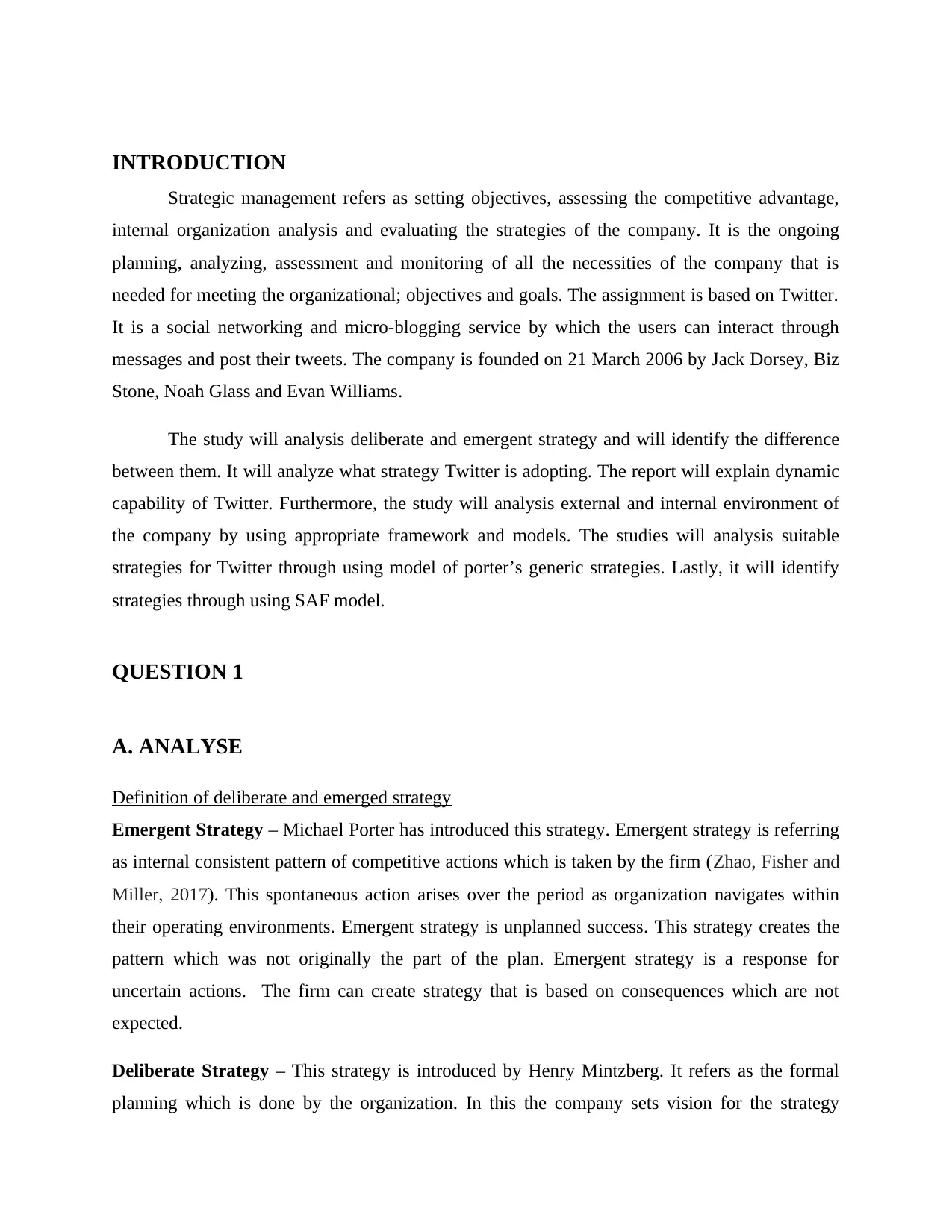
INTRODUCTION
Strategic management refers as setting objectives, assessing the competitive advantage,
internal organization analysis and evaluating the strategies of the company. It is the ongoing
planning, analyzing, assessment and monitoring of all the necessities of the company that is
needed for meeting the organizational; objectives and goals. The assignment is based on Twitter.
It is a social networking and micro-blogging service by which the users can interact through
messages and post their tweets. The company is founded on 21 March 2006 by Jack Dorsey, Biz
Stone, Noah Glass and Evan Williams.
The study will analysis deliberate and emergent strategy and will identify the difference
between them. It will analyze what strategy Twitter is adopting. The report will explain dynamic
capability of Twitter. Furthermore, the study will analysis external and internal environment of
the company by using appropriate framework and models. The studies will analysis suitable
strategies for Twitter through using model of porter’s generic strategies. Lastly, it will identify
strategies through using SAF model.
QUESTION 1
A. ANALYSE
Definition of deliberate and emerged strategy
Emergent Strategy – Michael Porter has introduced this strategy. Emergent strategy is referring
as internal consistent pattern of competitive actions which is taken by the firm (Zhao, Fisher and
Miller, 2017). This spontaneous action arises over the period as organization navigates within
their operating environments. Emergent strategy is unplanned success. This strategy creates the
pattern which was not originally the part of the plan. Emergent strategy is a response for
uncertain actions. The firm can create strategy that is based on consequences which are not
expected.
Deliberate Strategy – This strategy is introduced by Henry Mintzberg. It refers as the formal
planning which is done by the organization. In this the company sets vision for the strategy
Strategic management refers as setting objectives, assessing the competitive advantage,
internal organization analysis and evaluating the strategies of the company. It is the ongoing
planning, analyzing, assessment and monitoring of all the necessities of the company that is
needed for meeting the organizational; objectives and goals. The assignment is based on Twitter.
It is a social networking and micro-blogging service by which the users can interact through
messages and post their tweets. The company is founded on 21 March 2006 by Jack Dorsey, Biz
Stone, Noah Glass and Evan Williams.
The study will analysis deliberate and emergent strategy and will identify the difference
between them. It will analyze what strategy Twitter is adopting. The report will explain dynamic
capability of Twitter. Furthermore, the study will analysis external and internal environment of
the company by using appropriate framework and models. The studies will analysis suitable
strategies for Twitter through using model of porter’s generic strategies. Lastly, it will identify
strategies through using SAF model.
QUESTION 1
A. ANALYSE
Definition of deliberate and emerged strategy
Emergent Strategy – Michael Porter has introduced this strategy. Emergent strategy is referring
as internal consistent pattern of competitive actions which is taken by the firm (Zhao, Fisher and
Miller, 2017). This spontaneous action arises over the period as organization navigates within
their operating environments. Emergent strategy is unplanned success. This strategy creates the
pattern which was not originally the part of the plan. Emergent strategy is a response for
uncertain actions. The firm can create strategy that is based on consequences which are not
expected.
Deliberate Strategy – This strategy is introduced by Henry Mintzberg. It refers as the formal
planning which is done by the organization. In this the company sets vision for the strategy
Paraphrase This Document
Need a fresh take? Get an instant paraphrase of this document with our AI Paraphraser
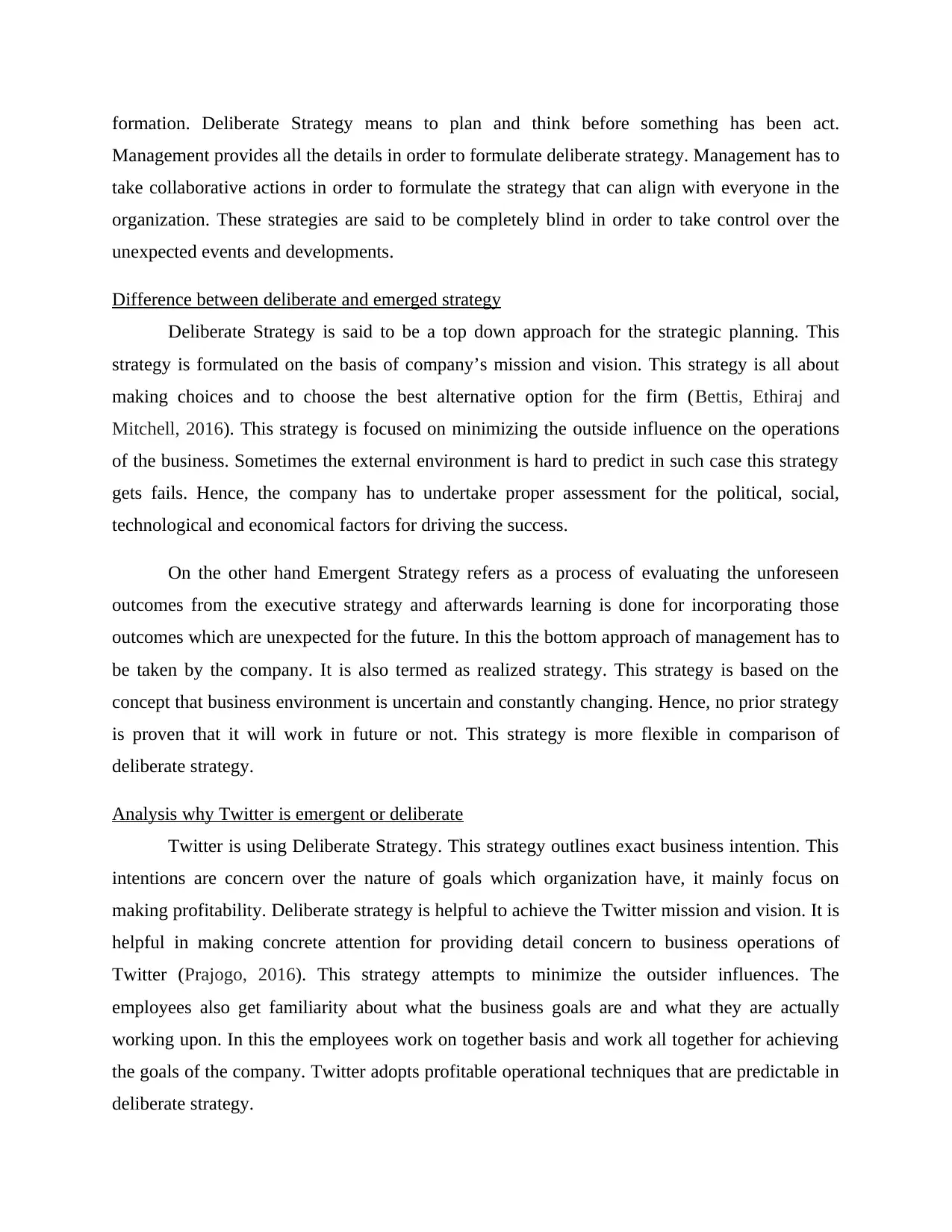
formation. Deliberate Strategy means to plan and think before something has been act.
Management provides all the details in order to formulate deliberate strategy. Management has to
take collaborative actions in order to formulate the strategy that can align with everyone in the
organization. These strategies are said to be completely blind in order to take control over the
unexpected events and developments.
Difference between deliberate and emerged strategy
Deliberate Strategy is said to be a top down approach for the strategic planning. This
strategy is formulated on the basis of company’s mission and vision. This strategy is all about
making choices and to choose the best alternative option for the firm (Bettis, Ethiraj and
Mitchell, 2016). This strategy is focused on minimizing the outside influence on the operations
of the business. Sometimes the external environment is hard to predict in such case this strategy
gets fails. Hence, the company has to undertake proper assessment for the political, social,
technological and economical factors for driving the success.
On the other hand Emergent Strategy refers as a process of evaluating the unforeseen
outcomes from the executive strategy and afterwards learning is done for incorporating those
outcomes which are unexpected for the future. In this the bottom approach of management has to
be taken by the company. It is also termed as realized strategy. This strategy is based on the
concept that business environment is uncertain and constantly changing. Hence, no prior strategy
is proven that it will work in future or not. This strategy is more flexible in comparison of
deliberate strategy.
Analysis why Twitter is emergent or deliberate
Twitter is using Deliberate Strategy. This strategy outlines exact business intention. This
intentions are concern over the nature of goals which organization have, it mainly focus on
making profitability. Deliberate strategy is helpful to achieve the Twitter mission and vision. It is
helpful in making concrete attention for providing detail concern to business operations of
Twitter (Prajogo, 2016). This strategy attempts to minimize the outsider influences. The
employees also get familiarity about what the business goals are and what they are actually
working upon. In this the employees work on together basis and work all together for achieving
the goals of the company. Twitter adopts profitable operational techniques that are predictable in
deliberate strategy.
Management provides all the details in order to formulate deliberate strategy. Management has to
take collaborative actions in order to formulate the strategy that can align with everyone in the
organization. These strategies are said to be completely blind in order to take control over the
unexpected events and developments.
Difference between deliberate and emerged strategy
Deliberate Strategy is said to be a top down approach for the strategic planning. This
strategy is formulated on the basis of company’s mission and vision. This strategy is all about
making choices and to choose the best alternative option for the firm (Bettis, Ethiraj and
Mitchell, 2016). This strategy is focused on minimizing the outside influence on the operations
of the business. Sometimes the external environment is hard to predict in such case this strategy
gets fails. Hence, the company has to undertake proper assessment for the political, social,
technological and economical factors for driving the success.
On the other hand Emergent Strategy refers as a process of evaluating the unforeseen
outcomes from the executive strategy and afterwards learning is done for incorporating those
outcomes which are unexpected for the future. In this the bottom approach of management has to
be taken by the company. It is also termed as realized strategy. This strategy is based on the
concept that business environment is uncertain and constantly changing. Hence, no prior strategy
is proven that it will work in future or not. This strategy is more flexible in comparison of
deliberate strategy.
Analysis why Twitter is emergent or deliberate
Twitter is using Deliberate Strategy. This strategy outlines exact business intention. This
intentions are concern over the nature of goals which organization have, it mainly focus on
making profitability. Deliberate strategy is helpful to achieve the Twitter mission and vision. It is
helpful in making concrete attention for providing detail concern to business operations of
Twitter (Prajogo, 2016). This strategy attempts to minimize the outsider influences. The
employees also get familiarity about what the business goals are and what they are actually
working upon. In this the employees work on together basis and work all together for achieving
the goals of the company. Twitter adopts profitable operational techniques that are predictable in
deliberate strategy.
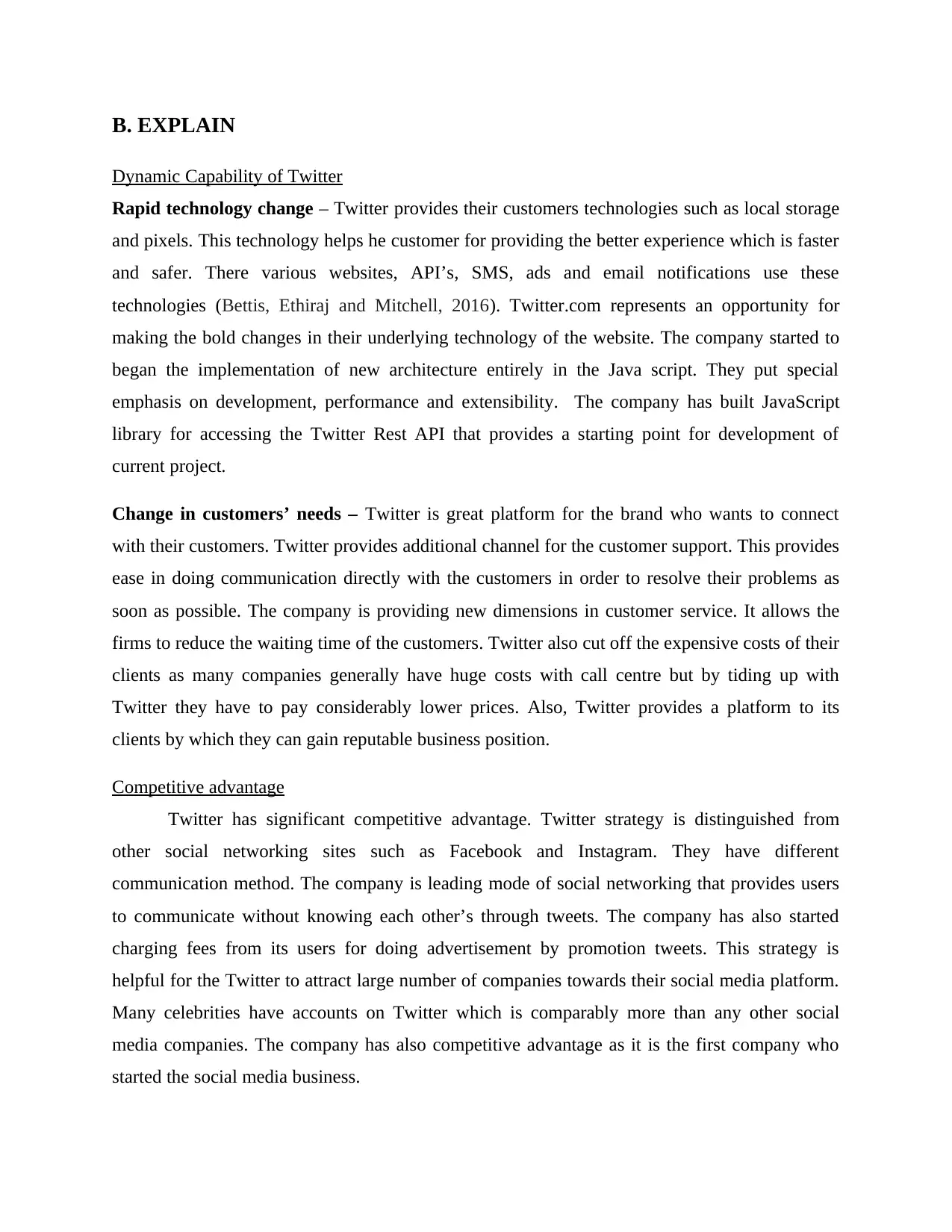
B. EXPLAIN
Dynamic Capability of Twitter
Rapid technology change – Twitter provides their customers technologies such as local storage
and pixels. This technology helps he customer for providing the better experience which is faster
and safer. There various websites, API’s, SMS, ads and email notifications use these
technologies (Bettis, Ethiraj and Mitchell, 2016). Twitter.com represents an opportunity for
making the bold changes in their underlying technology of the website. The company started to
began the implementation of new architecture entirely in the Java script. They put special
emphasis on development, performance and extensibility. The company has built JavaScript
library for accessing the Twitter Rest API that provides a starting point for development of
current project.
Change in customers’ needs – Twitter is great platform for the brand who wants to connect
with their customers. Twitter provides additional channel for the customer support. This provides
ease in doing communication directly with the customers in order to resolve their problems as
soon as possible. The company is providing new dimensions in customer service. It allows the
firms to reduce the waiting time of the customers. Twitter also cut off the expensive costs of their
clients as many companies generally have huge costs with call centre but by tiding up with
Twitter they have to pay considerably lower prices. Also, Twitter provides a platform to its
clients by which they can gain reputable business position.
Competitive advantage
Twitter has significant competitive advantage. Twitter strategy is distinguished from
other social networking sites such as Facebook and Instagram. They have different
communication method. The company is leading mode of social networking that provides users
to communicate without knowing each other’s through tweets. The company has also started
charging fees from its users for doing advertisement by promotion tweets. This strategy is
helpful for the Twitter to attract large number of companies towards their social media platform.
Many celebrities have accounts on Twitter which is comparably more than any other social
media companies. The company has also competitive advantage as it is the first company who
started the social media business.
Dynamic Capability of Twitter
Rapid technology change – Twitter provides their customers technologies such as local storage
and pixels. This technology helps he customer for providing the better experience which is faster
and safer. There various websites, API’s, SMS, ads and email notifications use these
technologies (Bettis, Ethiraj and Mitchell, 2016). Twitter.com represents an opportunity for
making the bold changes in their underlying technology of the website. The company started to
began the implementation of new architecture entirely in the Java script. They put special
emphasis on development, performance and extensibility. The company has built JavaScript
library for accessing the Twitter Rest API that provides a starting point for development of
current project.
Change in customers’ needs – Twitter is great platform for the brand who wants to connect
with their customers. Twitter provides additional channel for the customer support. This provides
ease in doing communication directly with the customers in order to resolve their problems as
soon as possible. The company is providing new dimensions in customer service. It allows the
firms to reduce the waiting time of the customers. Twitter also cut off the expensive costs of their
clients as many companies generally have huge costs with call centre but by tiding up with
Twitter they have to pay considerably lower prices. Also, Twitter provides a platform to its
clients by which they can gain reputable business position.
Competitive advantage
Twitter has significant competitive advantage. Twitter strategy is distinguished from
other social networking sites such as Facebook and Instagram. They have different
communication method. The company is leading mode of social networking that provides users
to communicate without knowing each other’s through tweets. The company has also started
charging fees from its users for doing advertisement by promotion tweets. This strategy is
helpful for the Twitter to attract large number of companies towards their social media platform.
Many celebrities have accounts on Twitter which is comparably more than any other social
media companies. The company has also competitive advantage as it is the first company who
started the social media business.
⊘ This is a preview!⊘
Do you want full access?
Subscribe today to unlock all pages.

Trusted by 1+ million students worldwide
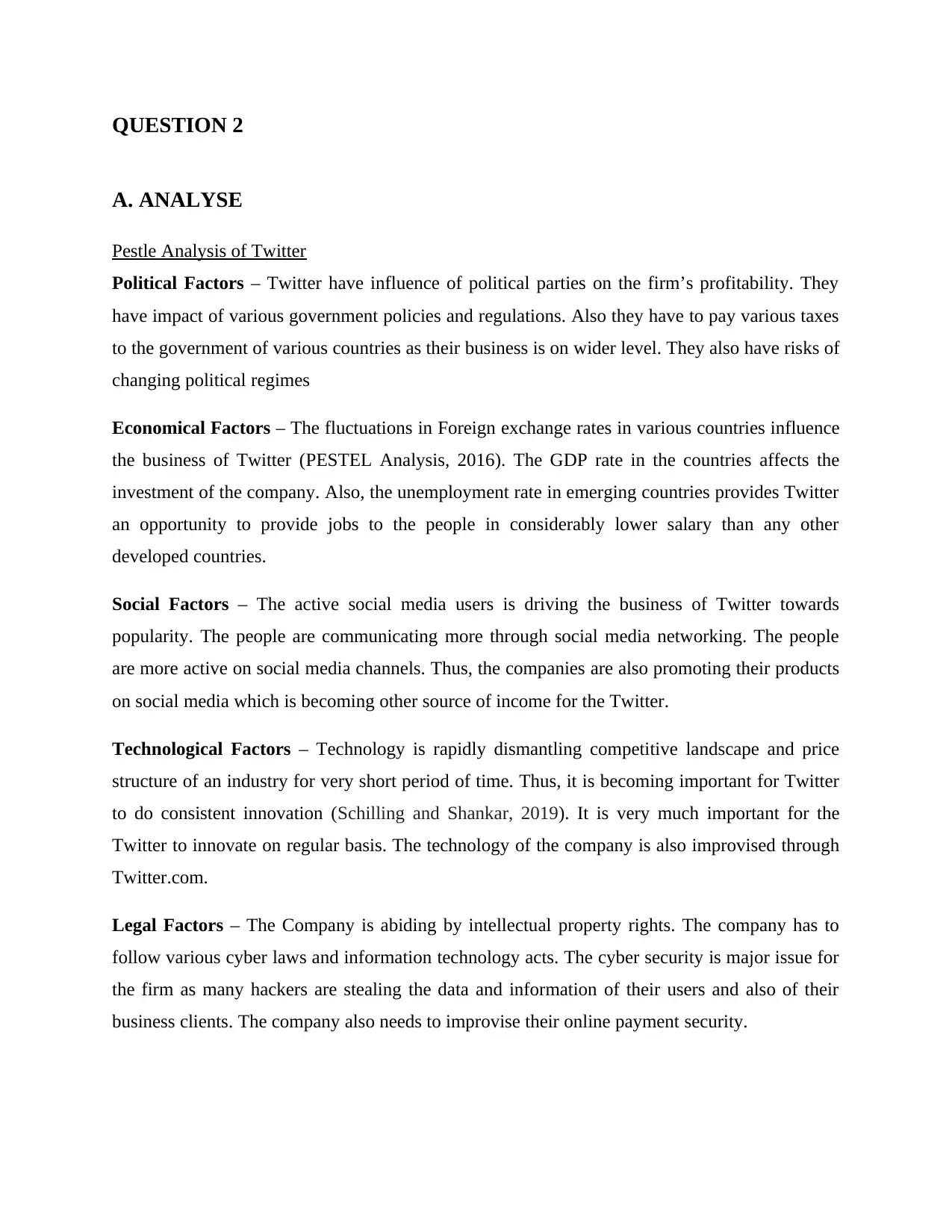
QUESTION 2
A. ANALYSE
Pestle Analysis of Twitter
Political Factors – Twitter have influence of political parties on the firm’s profitability. They
have impact of various government policies and regulations. Also they have to pay various taxes
to the government of various countries as their business is on wider level. They also have risks of
changing political regimes
Economical Factors – The fluctuations in Foreign exchange rates in various countries influence
the business of Twitter (PESTEL Analysis, 2016). The GDP rate in the countries affects the
investment of the company. Also, the unemployment rate in emerging countries provides Twitter
an opportunity to provide jobs to the people in considerably lower salary than any other
developed countries.
Social Factors – The active social media users is driving the business of Twitter towards
popularity. The people are communicating more through social media networking. The people
are more active on social media channels. Thus, the companies are also promoting their products
on social media which is becoming other source of income for the Twitter.
Technological Factors – Technology is rapidly dismantling competitive landscape and price
structure of an industry for very short period of time. Thus, it is becoming important for Twitter
to do consistent innovation (Schilling and Shankar, 2019). It is very much important for the
Twitter to innovate on regular basis. The technology of the company is also improvised through
Twitter.com.
Legal Factors – The Company is abiding by intellectual property rights. The company has to
follow various cyber laws and information technology acts. The cyber security is major issue for
the firm as many hackers are stealing the data and information of their users and also of their
business clients. The company also needs to improvise their online payment security.
A. ANALYSE
Pestle Analysis of Twitter
Political Factors – Twitter have influence of political parties on the firm’s profitability. They
have impact of various government policies and regulations. Also they have to pay various taxes
to the government of various countries as their business is on wider level. They also have risks of
changing political regimes
Economical Factors – The fluctuations in Foreign exchange rates in various countries influence
the business of Twitter (PESTEL Analysis, 2016). The GDP rate in the countries affects the
investment of the company. Also, the unemployment rate in emerging countries provides Twitter
an opportunity to provide jobs to the people in considerably lower salary than any other
developed countries.
Social Factors – The active social media users is driving the business of Twitter towards
popularity. The people are communicating more through social media networking. The people
are more active on social media channels. Thus, the companies are also promoting their products
on social media which is becoming other source of income for the Twitter.
Technological Factors – Technology is rapidly dismantling competitive landscape and price
structure of an industry for very short period of time. Thus, it is becoming important for Twitter
to do consistent innovation (Schilling and Shankar, 2019). It is very much important for the
Twitter to innovate on regular basis. The technology of the company is also improvised through
Twitter.com.
Legal Factors – The Company is abiding by intellectual property rights. The company has to
follow various cyber laws and information technology acts. The cyber security is major issue for
the firm as many hackers are stealing the data and information of their users and also of their
business clients. The company also needs to improvise their online payment security.
Paraphrase This Document
Need a fresh take? Get an instant paraphrase of this document with our AI Paraphraser
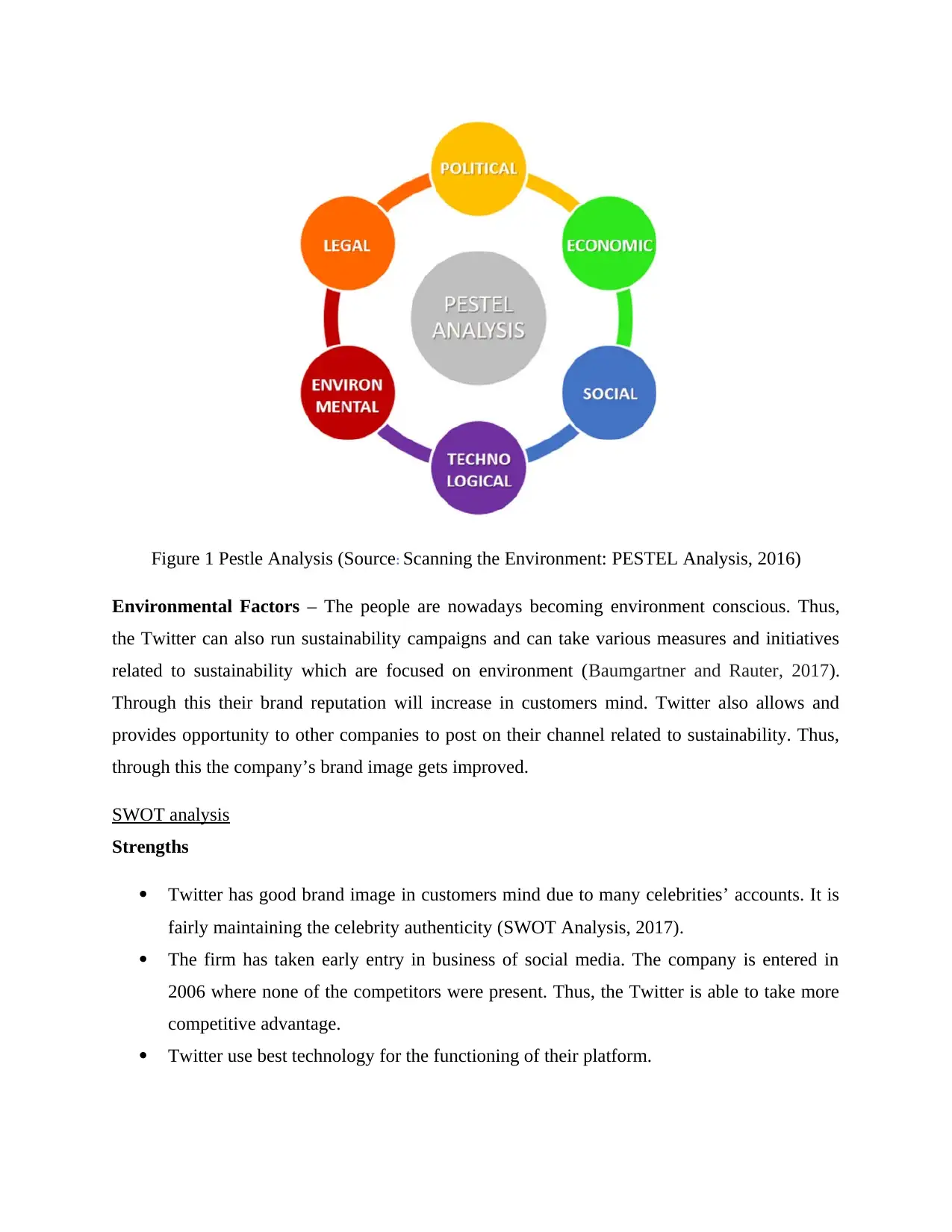
Figure 1 Pestle Analysis (Source: Scanning the Environment: PESTEL Analysis, 2016)
Environmental Factors – The people are nowadays becoming environment conscious. Thus,
the Twitter can also run sustainability campaigns and can take various measures and initiatives
related to sustainability which are focused on environment (Baumgartner and Rauter, 2017).
Through this their brand reputation will increase in customers mind. Twitter also allows and
provides opportunity to other companies to post on their channel related to sustainability. Thus,
through this the company’s brand image gets improved.
SWOT analysis
Strengths
Twitter has good brand image in customers mind due to many celebrities’ accounts. It is
fairly maintaining the celebrity authenticity (SWOT Analysis, 2017).
The firm has taken early entry in business of social media. The company is entered in
2006 where none of the competitors were present. Thus, the Twitter is able to take more
competitive advantage.
Twitter use best technology for the functioning of their platform.
Environmental Factors – The people are nowadays becoming environment conscious. Thus,
the Twitter can also run sustainability campaigns and can take various measures and initiatives
related to sustainability which are focused on environment (Baumgartner and Rauter, 2017).
Through this their brand reputation will increase in customers mind. Twitter also allows and
provides opportunity to other companies to post on their channel related to sustainability. Thus,
through this the company’s brand image gets improved.
SWOT analysis
Strengths
Twitter has good brand image in customers mind due to many celebrities’ accounts. It is
fairly maintaining the celebrity authenticity (SWOT Analysis, 2017).
The firm has taken early entry in business of social media. The company is entered in
2006 where none of the competitors were present. Thus, the Twitter is able to take more
competitive advantage.
Twitter use best technology for the functioning of their platform.
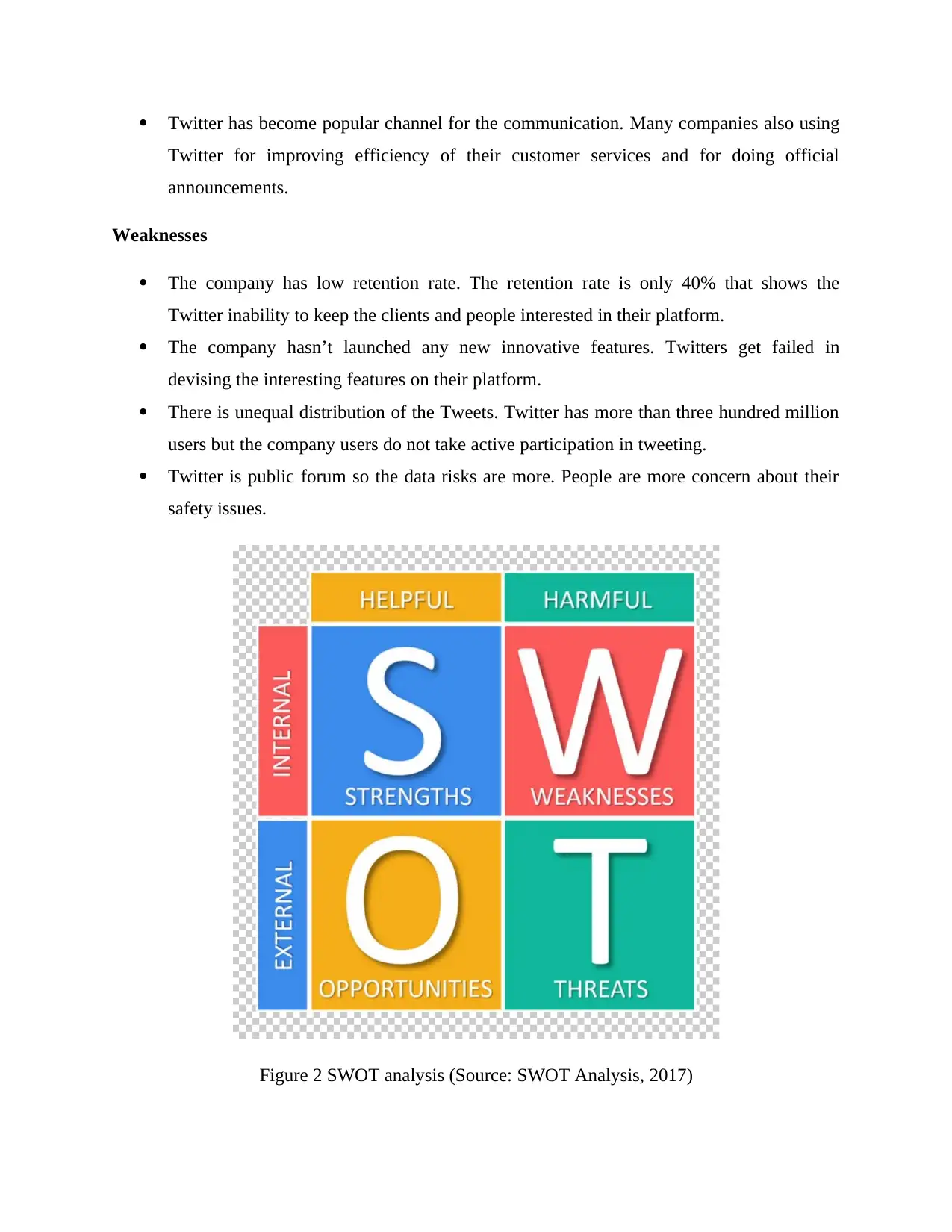
Twitter has become popular channel for the communication. Many companies also using
Twitter for improving efficiency of their customer services and for doing official
announcements.
Weaknesses
The company has low retention rate. The retention rate is only 40% that shows the
Twitter inability to keep the clients and people interested in their platform.
The company hasn’t launched any new innovative features. Twitters get failed in
devising the interesting features on their platform.
There is unequal distribution of the Tweets. Twitter has more than three hundred million
users but the company users do not take active participation in tweeting.
Twitter is public forum so the data risks are more. People are more concern about their
safety issues.
Figure 2 SWOT analysis (Source: SWOT Analysis, 2017)
Twitter for improving efficiency of their customer services and for doing official
announcements.
Weaknesses
The company has low retention rate. The retention rate is only 40% that shows the
Twitter inability to keep the clients and people interested in their platform.
The company hasn’t launched any new innovative features. Twitters get failed in
devising the interesting features on their platform.
There is unequal distribution of the Tweets. Twitter has more than three hundred million
users but the company users do not take active participation in tweeting.
Twitter is public forum so the data risks are more. People are more concern about their
safety issues.
Figure 2 SWOT analysis (Source: SWOT Analysis, 2017)
⊘ This is a preview!⊘
Do you want full access?
Subscribe today to unlock all pages.

Trusted by 1+ million students worldwide
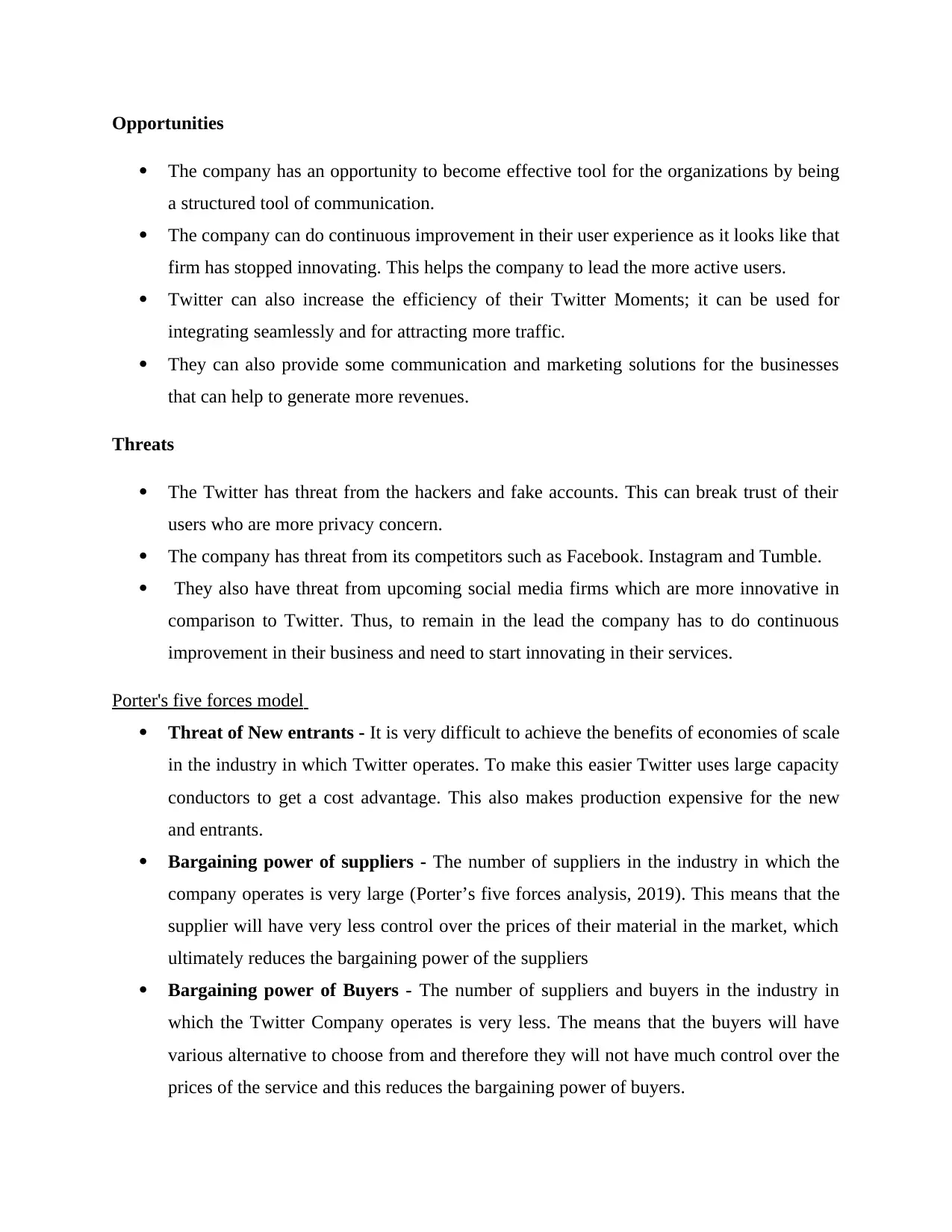
Opportunities
The company has an opportunity to become effective tool for the organizations by being
a structured tool of communication.
The company can do continuous improvement in their user experience as it looks like that
firm has stopped innovating. This helps the company to lead the more active users.
Twitter can also increase the efficiency of their Twitter Moments; it can be used for
integrating seamlessly and for attracting more traffic.
They can also provide some communication and marketing solutions for the businesses
that can help to generate more revenues.
Threats
The Twitter has threat from the hackers and fake accounts. This can break trust of their
users who are more privacy concern.
The company has threat from its competitors such as Facebook. Instagram and Tumble.
They also have threat from upcoming social media firms which are more innovative in
comparison to Twitter. Thus, to remain in the lead the company has to do continuous
improvement in their business and need to start innovating in their services.
Porter's five forces model
Threat of New entrants - It is very difficult to achieve the benefits of economies of scale
in the industry in which Twitter operates. To make this easier Twitter uses large capacity
conductors to get a cost advantage. This also makes production expensive for the new
and entrants.
Bargaining power of suppliers - The number of suppliers in the industry in which the
company operates is very large (Porter’s five forces analysis, 2019). This means that the
supplier will have very less control over the prices of their material in the market, which
ultimately reduces the bargaining power of the suppliers
Bargaining power of Buyers - The number of suppliers and buyers in the industry in
which the Twitter Company operates is very less. The means that the buyers will have
various alternative to choose from and therefore they will not have much control over the
prices of the service and this reduces the bargaining power of buyers.
The company has an opportunity to become effective tool for the organizations by being
a structured tool of communication.
The company can do continuous improvement in their user experience as it looks like that
firm has stopped innovating. This helps the company to lead the more active users.
Twitter can also increase the efficiency of their Twitter Moments; it can be used for
integrating seamlessly and for attracting more traffic.
They can also provide some communication and marketing solutions for the businesses
that can help to generate more revenues.
Threats
The Twitter has threat from the hackers and fake accounts. This can break trust of their
users who are more privacy concern.
The company has threat from its competitors such as Facebook. Instagram and Tumble.
They also have threat from upcoming social media firms which are more innovative in
comparison to Twitter. Thus, to remain in the lead the company has to do continuous
improvement in their business and need to start innovating in their services.
Porter's five forces model
Threat of New entrants - It is very difficult to achieve the benefits of economies of scale
in the industry in which Twitter operates. To make this easier Twitter uses large capacity
conductors to get a cost advantage. This also makes production expensive for the new
and entrants.
Bargaining power of suppliers - The number of suppliers in the industry in which the
company operates is very large (Porter’s five forces analysis, 2019). This means that the
supplier will have very less control over the prices of their material in the market, which
ultimately reduces the bargaining power of the suppliers
Bargaining power of Buyers - The number of suppliers and buyers in the industry in
which the Twitter Company operates is very less. The means that the buyers will have
various alternative to choose from and therefore they will not have much control over the
prices of the service and this reduces the bargaining power of buyers.
Paraphrase This Document
Need a fresh take? Get an instant paraphrase of this document with our AI Paraphraser
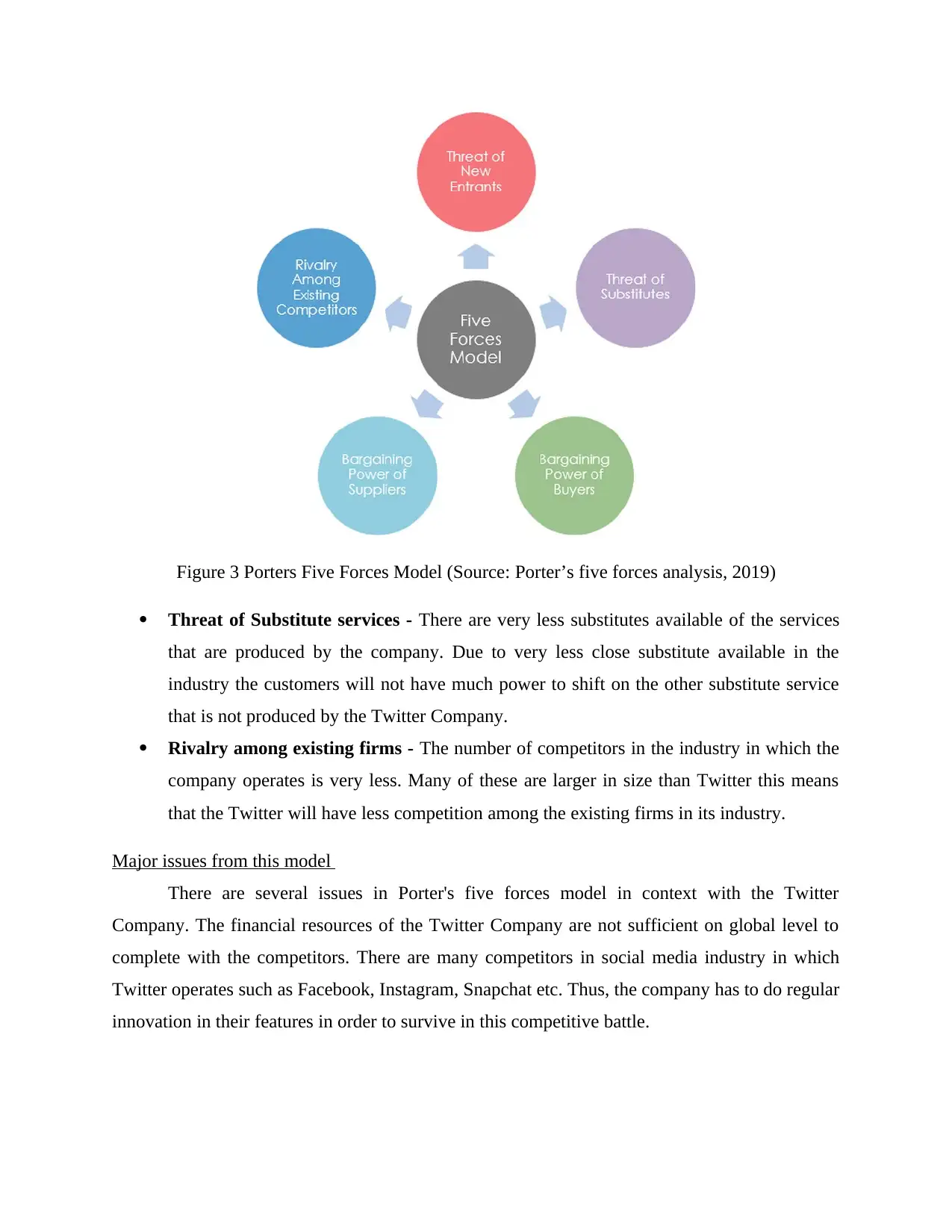
Figure 3 Porters Five Forces Model (Source: Porter’s five forces analysis, 2019)
Threat of Substitute services - There are very less substitutes available of the services
that are produced by the company. Due to very less close substitute available in the
industry the customers will not have much power to shift on the other substitute service
that is not produced by the Twitter Company.
Rivalry among existing firms - The number of competitors in the industry in which the
company operates is very less. Many of these are larger in size than Twitter this means
that the Twitter will have less competition among the existing firms in its industry.
Major issues from this model
There are several issues in Porter's five forces model in context with the Twitter
Company. The financial resources of the Twitter Company are not sufficient on global level to
complete with the competitors. There are many competitors in social media industry in which
Twitter operates such as Facebook, Instagram, Snapchat etc. Thus, the company has to do regular
innovation in their features in order to survive in this competitive battle.
Threat of Substitute services - There are very less substitutes available of the services
that are produced by the company. Due to very less close substitute available in the
industry the customers will not have much power to shift on the other substitute service
that is not produced by the Twitter Company.
Rivalry among existing firms - The number of competitors in the industry in which the
company operates is very less. Many of these are larger in size than Twitter this means
that the Twitter will have less competition among the existing firms in its industry.
Major issues from this model
There are several issues in Porter's five forces model in context with the Twitter
Company. The financial resources of the Twitter Company are not sufficient on global level to
complete with the competitors. There are many competitors in social media industry in which
Twitter operates such as Facebook, Instagram, Snapchat etc. Thus, the company has to do regular
innovation in their features in order to survive in this competitive battle.
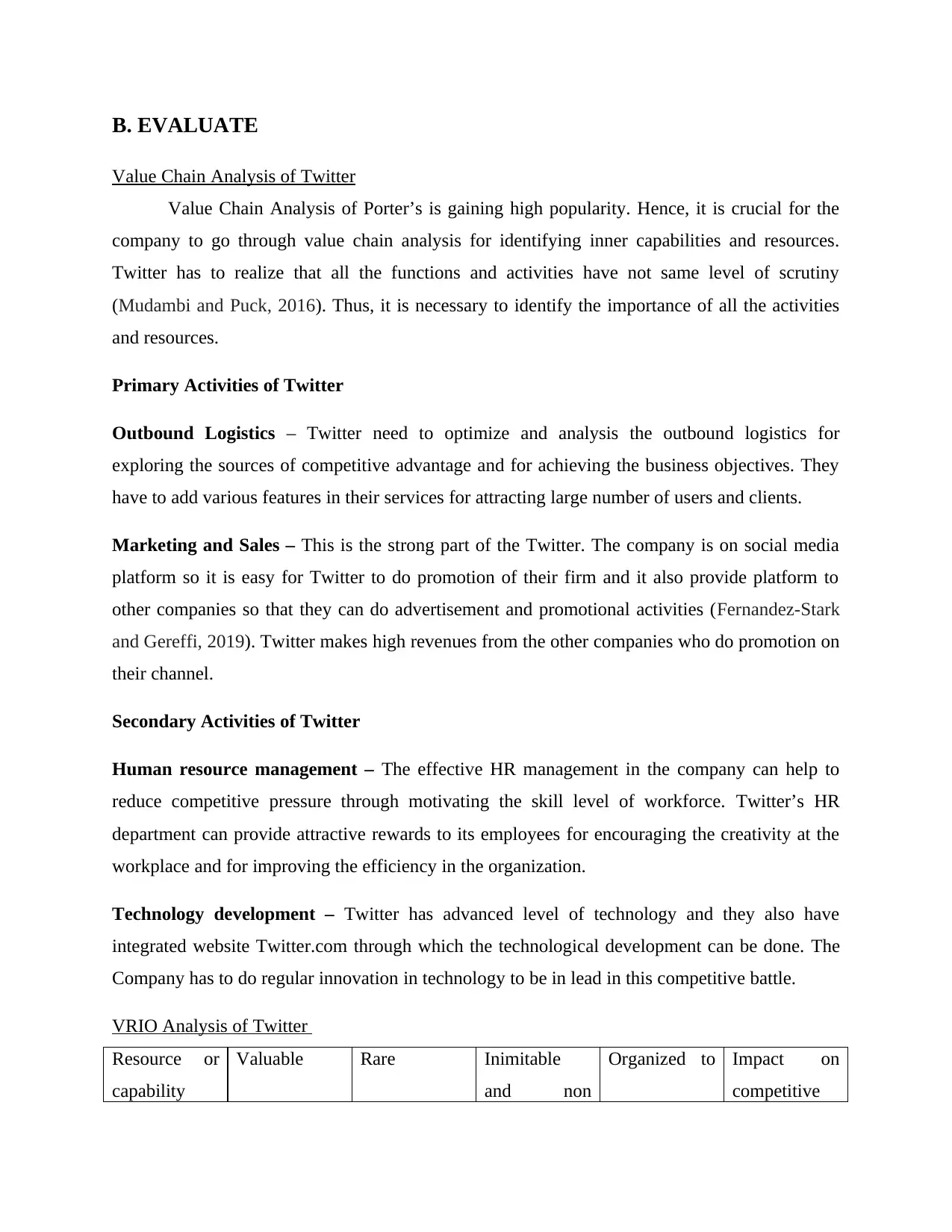
B. EVALUATE
Value Chain Analysis of Twitter
Value Chain Analysis of Porter’s is gaining high popularity. Hence, it is crucial for the
company to go through value chain analysis for identifying inner capabilities and resources.
Twitter has to realize that all the functions and activities have not same level of scrutiny
(Mudambi and Puck, 2016). Thus, it is necessary to identify the importance of all the activities
and resources.
Primary Activities of Twitter
Outbound Logistics – Twitter need to optimize and analysis the outbound logistics for
exploring the sources of competitive advantage and for achieving the business objectives. They
have to add various features in their services for attracting large number of users and clients.
Marketing and Sales – This is the strong part of the Twitter. The company is on social media
platform so it is easy for Twitter to do promotion of their firm and it also provide platform to
other companies so that they can do advertisement and promotional activities (Fernandez-Stark
and Gereffi, 2019). Twitter makes high revenues from the other companies who do promotion on
their channel.
Secondary Activities of Twitter
Human resource management – The effective HR management in the company can help to
reduce competitive pressure through motivating the skill level of workforce. Twitter’s HR
department can provide attractive rewards to its employees for encouraging the creativity at the
workplace and for improving the efficiency in the organization.
Technology development – Twitter has advanced level of technology and they also have
integrated website Twitter.com through which the technological development can be done. The
Company has to do regular innovation in technology to be in lead in this competitive battle.
VRIO Analysis of Twitter
Resource or
capability
Valuable Rare Inimitable
and non
Organized to Impact on
competitive
Value Chain Analysis of Twitter
Value Chain Analysis of Porter’s is gaining high popularity. Hence, it is crucial for the
company to go through value chain analysis for identifying inner capabilities and resources.
Twitter has to realize that all the functions and activities have not same level of scrutiny
(Mudambi and Puck, 2016). Thus, it is necessary to identify the importance of all the activities
and resources.
Primary Activities of Twitter
Outbound Logistics – Twitter need to optimize and analysis the outbound logistics for
exploring the sources of competitive advantage and for achieving the business objectives. They
have to add various features in their services for attracting large number of users and clients.
Marketing and Sales – This is the strong part of the Twitter. The company is on social media
platform so it is easy for Twitter to do promotion of their firm and it also provide platform to
other companies so that they can do advertisement and promotional activities (Fernandez-Stark
and Gereffi, 2019). Twitter makes high revenues from the other companies who do promotion on
their channel.
Secondary Activities of Twitter
Human resource management – The effective HR management in the company can help to
reduce competitive pressure through motivating the skill level of workforce. Twitter’s HR
department can provide attractive rewards to its employees for encouraging the creativity at the
workplace and for improving the efficiency in the organization.
Technology development – Twitter has advanced level of technology and they also have
integrated website Twitter.com through which the technological development can be done. The
Company has to do regular innovation in technology to be in lead in this competitive battle.
VRIO Analysis of Twitter
Resource or
capability
Valuable Rare Inimitable
and non
Organized to Impact on
competitive
⊘ This is a preview!⊘
Do you want full access?
Subscribe today to unlock all pages.

Trusted by 1+ million students worldwide
1 out of 21
Related Documents
Your All-in-One AI-Powered Toolkit for Academic Success.
+13062052269
info@desklib.com
Available 24*7 on WhatsApp / Email
![[object Object]](/_next/static/media/star-bottom.7253800d.svg)
Unlock your academic potential
Copyright © 2020–2025 A2Z Services. All Rights Reserved. Developed and managed by ZUCOL.





